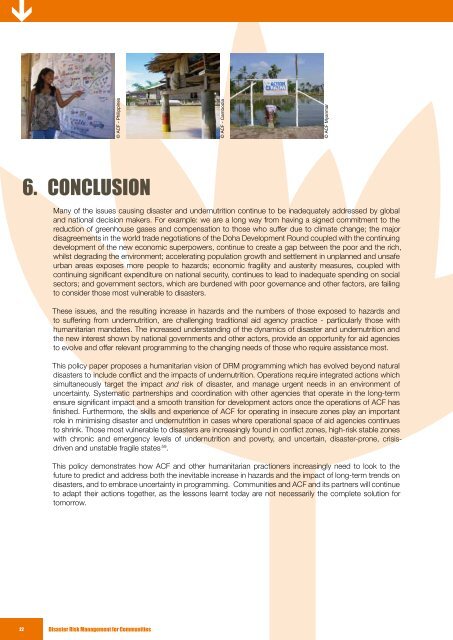DIsAsTER RIsk MANAgEMENT FOR COMMUNITIEs
DIsAsTER RIsk MANAgEMENT FOR COMMUNITIEs
DIsAsTER RIsk MANAgEMENT FOR COMMUNITIEs
- No tags were found...
You also want an ePaper? Increase the reach of your titles
YUMPU automatically turns print PDFs into web optimized ePapers that Google loves.
© ACF - Philippines<br />
© ACF - Cambodia<br />
© ACF Myanmar<br />
6. CONCLUSION<br />
Many of the issues causing disaster and undernutrition continue to be inadequately addressed by global<br />
and national decision makers. For example: we are a long way from having a signed commitment to the<br />
reduction of greenhouse gases and compensation to those who suffer due to climate change; the major<br />
disagreements in the world trade negotiations of the Doha Development Round coupled with the continuing<br />
development of the new economic superpowers, continue to create a gap between the poor and the rich,<br />
whilst degrading the environment; accelerating population growth and settlement in unplanned and unsafe<br />
urban areas exposes more people to hazards; economic fragility and austerity measures, coupled with<br />
continuing significant expenditure on national security, continues to lead to inadequate spending on social<br />
sectors; and government sectors, which are burdened with poor governance and other factors, are failing<br />
to consider those most vulnerable to disasters.<br />
These issues, and the resulting increase in hazards and the numbers of those exposed to hazards and<br />
to suffering from undernutrition, are challenging traditional aid agency practice - particularly those with<br />
humanitarian mandates. The increased understanding of the dynamics of disaster and undernutrition and<br />
the new interest shown by national governments and other actors, provide an opportunity for aid agencies<br />
to evolve and offer relevant programming to the changing needs of those who require assistance most.<br />
This policy paper proposes a humanitarian vision of DRM programming which has evolved beyond natural<br />
disasters to include conflict and the impacts of undernutrition. Operations require integrated actions which<br />
simultaneously target the impact and risk of disaster, and manage urgent needs in an environment of<br />
uncertainty. Systematic partnerships and coordination with other agencies that operate in the long-term<br />
ensure significant impact and a smooth transition for development actors once the operations of ACF has<br />
finished. Furthermore, the skills and experience of ACF for operating in insecure zones play an important<br />
role in minimising disaster and undernutrition in cases where operational space of aid agencies continues<br />
to shrink. Those most vulnerable to disasters are increasingly found in conflict zones, high-risk stable zones<br />
with chronic and emergency levels of undernutrition and poverty, and uncertain, disaster-prone, crisisdriven<br />
and unstable fragile states 59 .<br />
This policy demonstrates how ACF and other humanitarian practioners increasingly need to look to the<br />
future to predict and address both the inevitable increase in hazards and the impact of long-term trends on<br />
disasters, and to embrace uncertainty in programming. Communities and ACF and its partners will continue<br />
to adapt their actions together, as the lessons learnt today are not necessarily the complete solution for<br />
tomorrow.<br />
22 Disaster Risk Management for Communities

















